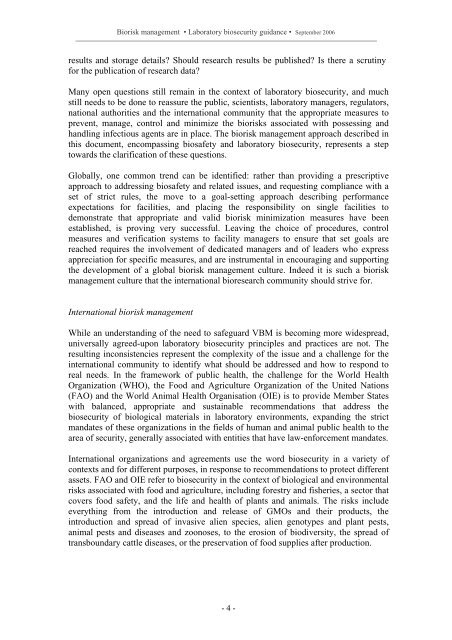Laboratory biosecurity guidance - World Health Organization
Laboratory biosecurity guidance - World Health Organization
Laboratory biosecurity guidance - World Health Organization
Create successful ePaper yourself
Turn your PDF publications into a flip-book with our unique Google optimized e-Paper software.
Biorisk management • <strong>Laboratory</strong> <strong>biosecurity</strong> <strong>guidance</strong> • September 2006<br />
results and storage details? Should research results be published? Is there a scrutiny<br />
for the publication of research data?<br />
Many open questions still remain in the context of laboratory <strong>biosecurity</strong>, and much<br />
still needs to be done to reassure the public, scientists, laboratory managers, regulators,<br />
national authorities and the international community that the appropriate measures to<br />
prevent, manage, control and minimize the biorisks associated with possessing and<br />
handling infectious agents are in place. The biorisk management approach described in<br />
this document, encompassing biosafety and laboratory <strong>biosecurity</strong>, represents a step<br />
towards the clarification of these questions.<br />
Globally, one common trend can be identified: rather than providing a prescriptive<br />
approach to addressing biosafety and related issues, and requesting compliance with a<br />
set of strict rules, the move to a goal-setting approach describing performance<br />
expectations for facilities, and placing the responsibility on single facilities to<br />
demonstrate that appropriate and valid biorisk minimization measures have been<br />
established, is proving very successful. Leaving the choice of procedures, control<br />
measures and verification systems to facility managers to ensure that set goals are<br />
reached requires the involvement of dedicated managers and of leaders who express<br />
appreciation for specific measures, and are instrumental in encouraging and supporting<br />
the development of a global biorisk management culture. Indeed it is such a biorisk<br />
management culture that the international bioresearch community should strive for.<br />
International biorisk management<br />
While an understanding of the need to safeguard VBM is becoming more widespread,<br />
universally agreed-upon laboratory <strong>biosecurity</strong> principles and practices are not. The<br />
resulting inconsistencies represent the complexity of the issue and a challenge for the<br />
international community to identify what should be addressed and how to respond to<br />
real needs. In the framework of public health, the challenge for the <strong>World</strong> <strong>Health</strong><br />
<strong>Organization</strong> (WHO), the Food and Agriculture <strong>Organization</strong> of the United Nations<br />
(FAO) and the <strong>World</strong> Animal <strong>Health</strong> Organisation (OIE) is to provide Member States<br />
with balanced, appropriate and sustainable recommendations that address the<br />
<strong>biosecurity</strong> of biological materials in laboratory environments, expanding the strict<br />
mandates of these organizations in the fields of human and animal public health to the<br />
area of security, generally associated with entities that have law-enforcement mandates.<br />
International organizations and agreements use the word <strong>biosecurity</strong> in a variety of<br />
contexts and for different purposes, in response to recommendations to protect different<br />
assets. FAO and OIE refer to <strong>biosecurity</strong> in the context of biological and environmental<br />
risks associated with food and agriculture, including forestry and fisheries, a sector that<br />
covers food safety, and the life and health of plants and animals. The risks include<br />
everything from the introduction and release of GMOs and their products, the<br />
introduction and spread of invasive alien species, alien genotypes and plant pests,<br />
animal pests and diseases and zoonoses, to the erosion of biodiversity, the spread of<br />
transboundary cattle diseases, or the preservation of food supplies after production.<br />
- 4 -

















